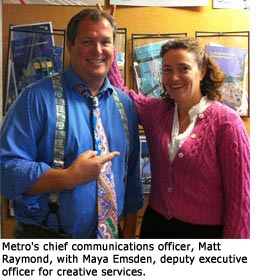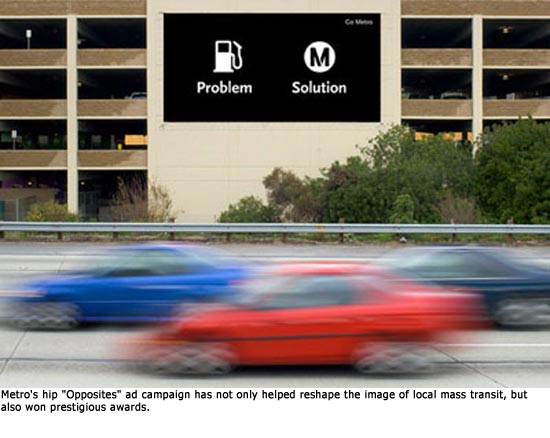Metro’s “Mad Men” riding high
October 20, 2010
Matt Raymond was an ad man on a mission when he set off for Metro headquarters in Los Angeles in 2002. Bound for a new job as the transportation authority’s incoming chief of communications, his first order of business was to find his new office at One Gateway Plaza. His second: “To make transit here cool.”
He didn’t fare so well on the first front. “You know how, when you get off the subway here, if you go one way you go to our building, and if you go the other way you go to Union Station?” Raymond confesses, chuckling. “Well, I went the wrong way.”
In his broader goal, however, everything seems to be headed down the right track. With a clear message and a talent pool that Don Draper himself would envy, Raymond’s in-house creative services department has spent the last eight years selling L.A. on mass transit the way gas-guzzlers have been pitched for generations by private ad agencies.
Under Raymond’s direction, Metro has been churning out the kind of prize-winning work usually associated with boutique ad firms. In the process, he and his team have reshaped the public image of the nation’s third-largest public transportation authority.
 The creative services department, whose 13-person staff generates all the ads, maps, graphics, web/mobile data, merchandising and fleet design for Metro, has won more than 50 awards in the past five years for its rebranding efforts, including at least a half-dozen this year from such organizations as Harvard University’s John F. Kennedy School of Government and the Society of Environmental Graphic Design. Raymond was personally recognized this year for “dramatic improvements” in changing the perception of transit at the industry’s international Metros Awards.
The creative services department, whose 13-person staff generates all the ads, maps, graphics, web/mobile data, merchandising and fleet design for Metro, has won more than 50 awards in the past five years for its rebranding efforts, including at least a half-dozen this year from such organizations as Harvard University’s John F. Kennedy School of Government and the Society of Environmental Graphic Design. Raymond was personally recognized this year for “dramatic improvements” in changing the perception of transit at the industry’s international Metros Awards.
It’s a far cry from the mid-1990s, when the conventional wisdom about public transportation in Southern California was that it was useless and/or dysfunctional. After investing billions in L.A.’s first subway system, the agency’s finances had crumbled, and headlines routinely billed the MTA as profligate, quarrelsome and prone to engineering screw-ups.
The authority eventually improved, first under the leadership of corporate turnaround specialist Julian Burke and then under the recently retired Roger Snoble. But until Raymond was brought aboard in 2002, the agency’s image lagged.
“There was awareness of the agency,” he says, “but it didn’t have a very positive perception.”
Like Snoble, Raymond had come to Los Angeles from Dallas’ transit system, where marketing—not just to individual riders, but to businesses and community stakeholders—had been central to the mission. Advertising, he had learned, was not just billboards and commercials when it came to persuading a car culture to try mass transportation; everything from the look of the buses to the ease of the maps had to be part of the sales pitch.
For example: That wrong turn he made on his first day? Poor salesmanship, he decided.
“The first thing I did when I got the job was put better signage in all the stations,” he recalls.
More broadly, he believed that Metro needed a single, strong voice if the agency had any hope of getting through to car-centric Southern California. “Unbelievably, the agency didn’t have a central communications unit,” recalls Maya Emsden, Raymond’s deputy executive officer for creative services. “We had over 300 departments/programs, each with their own logo and each doing their own communications. The public didn’t even know some of them were part of the agency.”
Raymond corralled all those initiatives under a single communications department. Then Metro’s buses were repainted to drive home that friendly, consistent image—bright red for the rapid buses, “California Poppy” for the community locals, and silver for the express vehicles that travel the Orange Line’s dedicated busway. Then came a series of highly effective advertising campaigns that sold Metro as the simple solution to traffic, gas prices and other problems.
One award-winning campaign used simple pairs of black-and-white logos to depict Metro as, for example, the “hero” to the smoggy car “villain”, or the “sweet” solution to “bitter” gas prices. The ubiquitous images were on everything from bus benches to the t-shirts of baristas at L.A. cafes.
The creative services group—a closely-knit team that includes four graphic designers, one web designer and one signage designer—was transformed into Metro’s own mini advertising agency and print shop, saving the MTA huge sums on outside consultants. The group also taps local universities and art schools for talented interns, 10 to 15 of whom are on staff at any given time.
“Working with Metro has become a coveted job in these design schools, not only because we’ve been winning these awards, but also because of the pace and quantity of the work,” says Emsden. “Most internships, you work four months just to get a single brochure out. Here, we produce, like, two a week.”
Although the advertising has gotten the most attention, about 95% of the group’s time is spent on basic customer information that includes signage, literature, maps and such web features as Facebook, Twitter and Metro’s popular new blog, The Source. Coming soon: a new mobile app that tells customers when their next bus arrives.
Ethan Arpi, who is conducting a study of transit marketing for EMBARQ, the transit arm of the World Resources Institute, an environmental advocacy organization and think tank, says one key to Metro’s success has been its decision to give organizational stature to its communications chief.
“L.A. isn’t a transit-friendly market. It’s not just, ‘If you build it, they will come’, Arpi says. “If you build it, you have to sell it.”
Although it’s difficult to definitively assess the impact of Metro’s marketing efforts, transit advocates widely credit the communications group with persuading Southern Californians that the transit authority everyone loved to hate in the 1990s was actually a clean, hip, worldly alternative to their beloved cars.
According to public opinion and customer satisfaction surveys due for release by December, public approval of the authority has risen in the past eight years to a solid 64% this year from a lackluster 41% in 2002.
Some 98% of the public has heard of Metro, 79% are familiar with its system of buses and subways and 75% know about an actual service, such as a bus stop or rail line, near them, says Raymond. Also—and this is no mean feat, given the number of names the system has had over the decades—54% of the public now refers to the authority by just one name, “Metro” (as opposed to LACMTA or MTA).
Despite the encouraging numbers, some critics of the marketing strategy argue that Metro would do better to spend its money on improving its transit systems.
“I think they would better serve the public by making the system more accessible, rather than these ads that just say, ‘We have a bus and you can avoid traffic by taking it’,” says Nate Berg, a contributing editor at Planetizen.com, an urban planning news web site based in L.A.
“We know we have a bus. What we don’t know is where it goes, and when it’ll get there, and whether it will be there for them when they’re drunk in a bar at two in the morning.”
That said, however, Berg added: “I’ve got to say, they’re all over the place. And some of their ads are pretty good.”
Posted 10/20/10














 405 bridge work causes a stink
405 bridge work causes a stink

